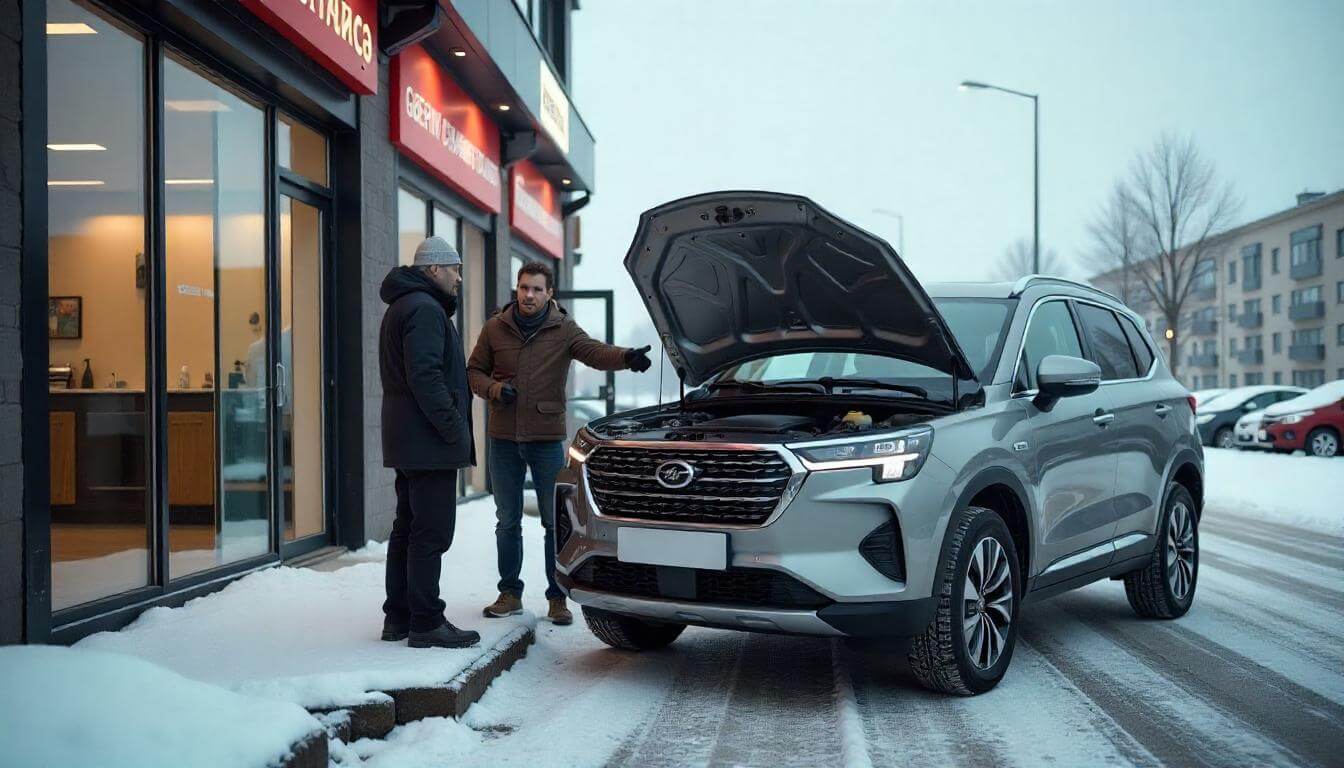In 2025, Chinese cars continue to gain popularity in Russia. However, along with the growth in sales, the number of complaints is also increasing. Problems with the warranty of Chinese cars have become one of the most discussed topics among owners. Refusals in repair, difficulties with spare parts and inconsistency of the stated conditions with reality - many people are faced with this. In this article I will deal with real cases and give recommendations on how to protect your rights.
Why are there difficulties with Chinese car warranties?
Chinese brands such as Geely, Chery and Haval offer attractive warranty periods - from 3 to 7 years or up to 200,000 kilometres of mileage. However, in practice, the conditions are often not so favourable. For example, the stated warranty may cover only the main components, such as engine and transmission. And for other parts, including electronics and suspension, the terms are much shorter - from 3 months to a year. In addition, many dealers refer to "non-warranty cases" if the breakdown is related to operation.
What parts are most often not covered under warranty?
Chinese car warranties often do not cover wear parts. For example, brake discs and plugs may have a warranty of only 6 months. Filters and the exhaust system are often excluded from the terms and conditions altogether. Also difficulties arise with electronics. Changan owners complain that control units burn out due to errors, but dealers refuse to repair if the case is recognised as non-warranty. This is especially true for cars imported under parallel import.
Impact of parallel imports on warranty
Parallel imported cars are often not serviced by official dealers. For example, owners of Geely Monjaro and Exeed LX have faced refusals in repair due to differences in software. Dealers refer to the fact that such cars are designed for the Chinese market. As a result, owners are forced to repair the cars at their own expense. This is one of the main reasons why there are difficulties with the warranty on Chinese cars.
Real cases of refusal of warranty repair
Chinese car owners often share their stories. For example, one owner of an Omoda S5 GT experienced a gearbox failure after only 33 kilometres of mileage. The dealer tried to fix the problem but ended up ordering parts from China, which took several months. Another case involves an Exeed LX imported through Kazakhstan. The owner applied for repair of the camera in the mirror, but was refused because the car was not certified for Russia.
Electronics problems and their consequences
Electronics is a weak point of Chinese cars. Changan owners report burned control units, which cost up to 150,000 roubles. If the case is recognised as non-warranty, the owner pays for repairs. For example, connection of third-party equipment can be a reason for refusal. Difficulties also arise with cars imported under parallel import. Units for the Chinese market differ from the "official" ones, and dealers will not undertake repairs.
Cases with spare parts and long waiting times
Shortage of spare parts is another problem. In one case, the owner of a Geely Coolray had to wait two months for a bonnet after an accident. Prices for spare parts are also surprising: a bonnet for a Jetour Dashing costs 80,000 roubles. If the part does not fall under warranty, the wait can be long. In 2025, logistics from China remain difficult, and large parts warehouses in Russia are still rare. This exacerbates the problems with the warranty of Chinese cars.
How do dealers get around the warranty?
Dealers often look for reasons to deny repairs. For example, they may refer to "improper use". If you have not had your vehicle serviced by an authorised dealer, your warranty may be invalidated. Dealers also claim that there are no spare parts available or that the breakdown is not due to a factory defect. Haval owners complain that even with a stated warranty of 3 years or 150,000 kilometres on the F7 crossover, small parts such as the battery are only covered for a year.
Role of operating conditions in failures
Operating conditions in Russia - severe frosts, reagents, bad roads - often become a reason for failure. For example, body corrosion, which appears after 2-3 years, is not covered by the warranty. Dealers claim that it is the result of external factors. However, owners believe that the problem lies in the low quality of metal and lack of anti-corrosion treatment.
Problems with machines after warranty expiry
After the warranty expires, owners face new difficulties. For example, alternative services are reluctant to repair Chinese cars because of difficulties with electronics. One Li Auto owner complained that after the warranty expired, his car turned into a "brick" due to incompatibility of control units. This shows that Chinese car warranty problems can continue after the official deadline.
How do I protect my rights in case of warranty problems?
If you are faced with a refusal of warranty repair, do not give up. Firstly, carefully study the warranty terms in the contract. For example, Geely and Chery provide a warranty of 5 years or 150,000 kilometres for the engine and transmission, but other parts have shorter terms. Secondly, demand a written refusal from the dealer with the reasons. This will come in handy if you have to go to court.
Where to go for help?
If the dealer refuses to repair, contact the brand's representative office. For example, to the Russian office of Geely or Chery. You can also file a complaint with Rospotrebnadzor. If it comes to court, hire a lawyer specialising in consumer protection. In 2025, such cases are becoming more frequent, and the courts often side with the owners.
How do I properly service my car to keep my warranty intact?
To avoid problems, have your vehicle serviced only by an authorised dealer. For example, Haval requires servicing strictly according to the schedule. Also, keep all documents: receipts, purchase orders, certificates of work performed. If the dealer tries to cancel the warranty, these papers will help to prove your case. In addition, avoid installing third-party equipment, as this may be a reason for refusal.
How to minimise risks when buying a Chinese car?
Warranty problems with Chinese cars can be minimised if you approach your purchase wisely. Firstly, choose cars imported officially. They are better adapted to Russian conditions and have a full warranty. Secondly, clarify the terms of the warranty before signing the contract. For example, Exeed offers 7 years or 200,000 kilometres, but for some parts the warranty is only 6 months.
Is it worth it to buy a car on parallel imports?
Parallel imported cars are cheaper, but there are more risks. For example, dealers may refuse service because of software incompatibility. If you do choose this option, make sure that the seller provides at least one year of warranty repair. Also check the availability of spare parts for your model.
Which brands are more reliable in terms of warranty?
Among Chinese brands, Exeed is considered one of the leaders in terms of warranty conditions - 7 years or 200,000 km. However, in practice, owners complain about the quality of brake discs. Geely and Chery offer 5 years or 150,000 km, but with reservations on parts. Haval gives 3 years or 150,000 km on some models, but wear parts are excluded. Choose a brand that has a good reputation and a network of dealers in your area.
Future prospects for warranty services
In 2025, Chinese carmakers are beginning to realise the importance of warranty service. For example, some brands, such as Geely, have already extended warranty periods to 5 years. However, problems with spare parts and training of craftsmen remain. If the logistical situation improves and dealers start servicing cars better, confidence in Chinese cars will grow. But for now, owners need to be prepared for difficulties.
What changes are in store for the market?
In the coming years, Chinese brands may open more spare parts warehouses in Russia. It is also possible that independent services will appear to service "grey" cars. However, this will take time. For the time being, the problems with the warranty of Chinese cars remain relevant. Owners need to choose a dealer carefully and ensure that all conditions are met.
How do I prepare for possible problems?
To minimise the risks, find out in advance where you can have your car serviced after the end of the warranty. For example, large independent services are already starting to work with Chinese cars. Also keep contacts of lawyers on hand to help you defend your rights. If you plan to buy, choose a model with a good reputation and available spare parts.
Conclusion: how to deal with Chinese car warranty problems?
Chinese car warranty problems are a reality facing many owners in 2025. Repair refusals, parts shortages and difficulties with "grey" cars are only part of the difficulties. However, by knowing your rights and maintaining your car correctly, you can minimise the risks. Choose officially imported cars, carefully read the warranty terms and be ready to defend your interests. Then your Chinese car will bring more joy than problems.

 Warranty problems with Chinese cars: real cases and what to do in 2025">
Warranty problems with Chinese cars: real cases and what to do in 2025">
